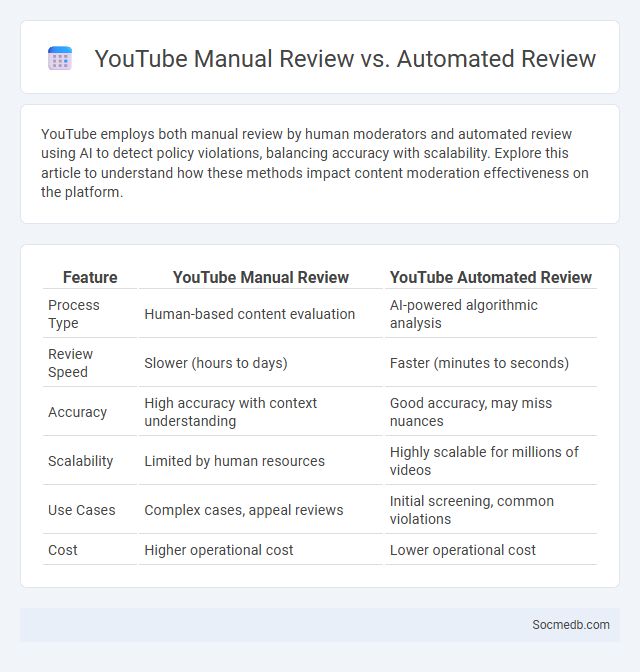
Photo illustration: YouTube Manual Review vs Automated Review
YouTube employs both manual review by human moderators and automated review using AI to detect policy violations, balancing accuracy with scalability. Explore this article to understand how these methods impact content moderation effectiveness on the platform.
Table of Comparison
| Feature | YouTube Manual Review | YouTube Automated Review |
|---|---|---|
| Process Type | Human-based content evaluation | AI-powered algorithmic analysis |
| Review Speed | Slower (hours to days) | Faster (minutes to seconds) |
| Accuracy | High accuracy with context understanding | Good accuracy, may miss nuances |
| Scalability | Limited by human resources | Highly scalable for millions of videos |
| Use Cases | Complex cases, appeal reviews | Initial screening, common violations |
| Cost | Higher operational cost | Lower operational cost |
Introduction to YouTube’s Content Review Systems
YouTube's content review systems utilize advanced AI algorithms combined with human moderators to efficiently identify and remove content that violates community guidelines. These systems analyze video metadata, captions, and visual elements to detect harmful or inappropriate material, ensuring a safer user environment. Constant updates to the review technology help adapt to emerging trends and maintain platform integrity.
What is Manual Review on YouTube?
Manual Review on YouTube involves human moderators examining flagged content to ensure it complies with platform policies and community guidelines. This process helps identify violations that automated systems might miss, such as subtle hate speech or nuanced copyright issues. When your video undergoes manual review, expect a thorough evaluation aimed at maintaining a safe and respectful environment for all users.
Understanding YouTube’s Automated Review Process
YouTube's automated review process uses machine learning algorithms to scan uploaded content for potential violations of community guidelines. This system analyzes video metadata, audio, and visual elements to detect copyright infractions, hate speech, and misinformation swiftly. While efficient, it sometimes results in false positives, prompting creators to appeal for human review to ensure fair content moderation.
Key Differences: Manual Review vs Automated Review
Manual review of social media content involves human evaluators assessing posts for context, sentiment, and nuanced meaning, ensuring nuanced and accurate judgment. Automated review uses algorithms and AI to quickly analyze large volumes of data, focusing on keyword detection and pattern recognition for faster but less contextual moderation. Your choice between manual and automated review impacts the balance between precision and efficiency in maintaining social media quality and compliance.
Pros and Cons of Manual Review
Manual review in social media content moderation ensures nuanced understanding and context-sensitive decisions, reducing false positives and preserving user expression. This process demands significant human resources and time, potentially causing delays in response and higher operational costs. Despite scalability challenges, manual review enhances accuracy in detecting hate speech, misinformation, and policy violations.
Pros and Cons of Automated Review
Automated review systems on social media platforms efficiently analyze vast amounts of user content to identify harmful or inappropriate posts, providing faster moderation and reducing human workload. However, these systems can sometimes misinterpret context or nuance, leading to false positives or negatives that affect Your content visibility and user experience. Balancing automation with human oversight ensures more accurate moderation while maintaining platform integrity and user trust.
The Role of Demonetization in YouTube Reviews
Demonetization on YouTube significantly impacts content creators by reducing their revenue from ads, which can alter the type and quality of reviews published on the platform. Your ability to reach audiences depends on navigating demonetization policies that may limit the visibility of reviews discussing sensitive or controversial topics. Understanding these dynamics is crucial for maintaining engagement and ensuring your content complies with YouTube's monetization guidelines.
Impact of Review Types on Creators’ Revenue
Different review types on social media significantly influence creators' revenue by shaping audience trust and engagement levels. Positive reviews and influencer endorsements often lead to higher conversion rates and increased sponsorship opportunities. Conversely, negative or mixed reviews can decrease follower growth and reduce monetization potential, emphasizing the need for authentic content and transparent communication.
How to Appeal YouTube Review Decisions
To appeal YouTube review decisions effectively, users must first thoroughly understand YouTube's Community Guidelines and accurately identify the specific violation cited. Submitting a well-structured appeal requires clear, concise explanations supported by relevant evidence or context highlighting compliance with platform rules. Timely responses improve the likelihood of reconsideration, emphasizing respectful communication to maintain a constructive dialogue with YouTube's review team.
Future Trends: Improving YouTube Review Systems
Future trends in social media highlight significant advancements in YouTube's review systems, incorporating AI-driven content moderation to enhance accuracy and reduce false positives. Your experience will be improved through faster removal of inappropriate content while supporting creators with transparent appeal processes. Enhanced algorithms will also prioritize authentic engagement, combating fake reviews and promoting trustworthy video feedback.
 socmedb.com
socmedb.com